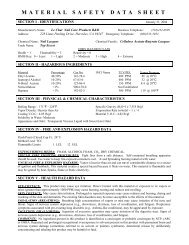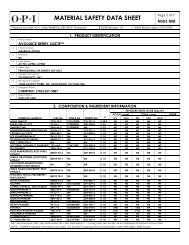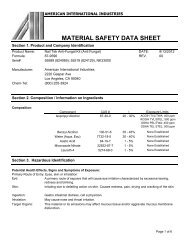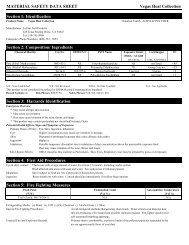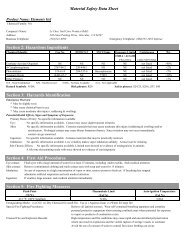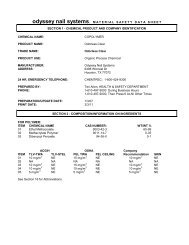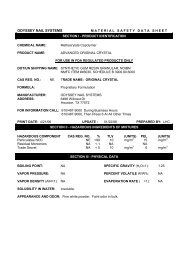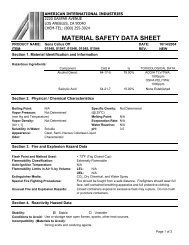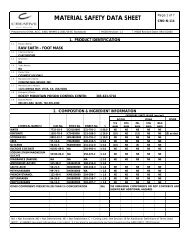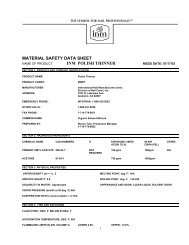MATERIAL SAFETY DATA SHEET Top Gel - ProfessionalBeautyMails
MATERIAL SAFETY DATA SHEET Top Gel - ProfessionalBeautyMails
MATERIAL SAFETY DATA SHEET Top Gel - ProfessionalBeautyMails
Create successful ePaper yourself
Turn your PDF publications into a flip-book with our unique Google optimized e-Paper software.
<strong>MATERIAL</strong> <strong>SAFETY</strong> <strong>DATA</strong> <strong>SHEET</strong> Date Issued: 2/11/05 Supersedes: ----I. Identification of the Substance/Preparation and the of the Company/UndertakingIdentification of the productProduct Name:<strong>Top</strong> <strong>Gel</strong>Company/undertaking identification:Company:Odyssey Nail Systems, Inc. Phone 1 407 522 57006498 Wilcrest Dr Fax 1 407 522 5788Houston, TX 77072Emergency Contact Information1 407 383-2662II.Composition on IngredientsSynonyms: Acrylated urethane blendCAS # WT% OSHA TWA ppm OSHA STEL ppm ACGIH TWA ppm ACGIH STEL ppmUrethane Diacrylate 215955-03-6 60-65 --- --- ---Urethane Pentaacrylate 052408-84-1 20-25 --- --- ---Isopropanol 67-63-0 4-5 --- --- ---Acetone 67-64-1 4-5 --- --- ---Photoinitiator 947-19-3 0.5-5 --- --- ------ Not established*** The specific chemical identity and/or weight percent is being withheld as a trade secretIII.IV.Hazard IdentificationIrritating to eyes. Repeated exposure may cause skin dryness, cracking or rash.First Aid MeasuresEye Contact: Flush with plenty of water for at least 15 minutes and seek medical attention.Skin Contact: Remove contaminated clothing and wash contact area with soap and water for 15 minutes. Particular attention should be paid to hair, nose, earsand other areas not easily cleaned. See section VIII . Note to physician: effects can be delayed 24-48 hours.Ingestion: If appreciable quantities are swallowed, seek medical attention.Inhalation: In case of exposure to a high concentration of vapor or mist, remove person to fresh air. If breathing has stopped, administer artificial respirationand seek medical attentionV. Fire-Fighting MeasuresExtinguishing Media:Use carbon dioxide or dry chemical for small fires; aqueous foam or water for large firesUnusual Fire and Explosion Hazards:High temperatures and fire conditions may cause rapid and uncontrolled polymerization which can result in explosions and and the violent ruptureof storage vessels and containers. Avoid the use of a stream of water to control fires since frothing can occur.Special Fire Fighting Procedure:Remove all ignition sources. Wear self-contained breathing apparatus and complete personal protective equipment when entering confined areawhere potential for exposure to vapors or products of combustion exists.VI.VI.VIII.IX.Accidental Release MeasuresSteps to Be Taken in Case Material is Released or Spilled:Spontaneous polymerization can occur. Eliminate ignition & heat sources. Use eye and skin protection. Place leaking containers in a wellventilated area. Absorb with inert material and dispose. Flush area with water; prevent washings from entering waterways. Spills or releases to theenvironment may be reportable to the National Response Center (800- 424-8802) and to state and local agencies.Waste Disposal Method:For large spills: incinerate or use biological treatment in accordance with federal, state and local regulations. For small spills: cure using UV light orperoxide and dispose in accordance with federal, state and local regulations.Handling & StorageStability: Normally StableConditions to Avoid:Storage >100F, exposure to light, loss of dissolved air, loss of polymerization inhibitor, contamination with incompatible materials.Materials to Avoid:Polymerization initiators including peroxides, strong oxidizing agents, copper, copper alloys, carbon steel, iron, rust and strong bases.Hazardous Decomposition Products:Fumes produces when heated to decomposition may include: carbon monoxide, carbon dioxide, oxides of nitrogen.Exposure Controls/Personal ProtectionRespiratory Protection:When exposed to aerosols or vapors, use full-face respirator with organic vapor cartridges that utilize a particulate pre-filter. In emergencysituations, or when used in confined spaces, use self-contained breathing apparatus or other air-supplied full face respirator.Ventilation:Local exhaust - recommended to control exposure which may result from operations generatingMechanical – Not recommended to control exposure for operations generating aerosols or vapors.Protective Gloves:Impervious gloves (neoprene). A combination of barrier cream, applied before exposure, and gloves is recommended. Do not apply cream afterexposure.Eye Protection:Chemical splash goggles or safety glasses when handing large quantities.Other Protective Equipment:NonePhysical and Chemical Properties:Manufacturer’s ID: <strong>Top</strong> Gloss Form: liquid
Product Class: Acrylated urethane Color: colorlessBoiling Range: 56.2F Percent Volatile by Volume: 7Vapor Density:n.a.VOC: 0.0 Weight Per Gallon: 8.9 lbsEvaporation Rate: >1 Vapor Pressure at 20C: n.a.Appearance and Odor: Clear liquid with mild odor Solubility in Water: insolubleFlashpoint:> 212 F SetaflashExplosion Limits: LEL: n.a. UEL: n.a.X. Stability and ReactivityStability: Normally StableHazardous Polymerization:May occur – uncontrolled polymerization may cause rapid evolution of heat and increased pressure that could result in violent rupture of sealedstorage vessels or containers.Conditions to Avoid:Storage >100F, exposure to light, loss of dissolved air, loss of polymerization inhibitor, contamination with incompatible materials.Materials to Avoid:Polymerization initiators including peroxides, strong oxidizing agents, copper, copper alloys, carbon steel, iron, rust and strong bases.Hazardous Decomposition Products:Fumes produces when heated to decomposition may include: carbon monoxide, carbon dioxide, oxides of nitrogen.XI.XII.XIII.Toxicological InformationHealth Hazards: See section VIngestion:n.a.Inhalation:n.a.Skin Contact: n.a.Allergy Sensitization: Mild skin and eye sensitization may be observed upon continued overexposureCarcinogenicity: Category E (evidence of non-carcinogenicity for humans)Mutagenicity: Negative in all testsECOLOGICAL INFORMATIONBiologic Degredation: Biodegredation: n.aBehavior in environmental compartments: Distribution: log p(o/w): n.a. no bioaccumulation to be expectedEcotoxic effects:Biological effects:Fish toxicity: L. macrochirus LC50: n.aDaphnia toxicity: Daphnia magna EC50:n.a.Maximum permissible toxic concentrations:Algeal toxicity: Sc. Quadricauda IC5: n.a.Bacterial toxicity: M. aeruginosa EC5: n.a.Protazoa: E. sulcatum EC5: n.a.Further ecological data:Degradability:BOD5: n.a.COD: n.a.TOD: n.a.DISPOSAL INFORMATIONProduct: Chemicals must be disposed of in compliance with federal, state and local regulations.Container: Container must be disposed of in accordance with federal, state and local regulations.XIV.Transportation InformationD.O.T. Shipping Name:D.O.T. Hazard Class:D.O.T. Label(s):D.O.T. UN/NA Number:polyurethane resinnonenonenoneXV.Regulatory InformationIn The EU:Classification and Labeling (according to 88/379/EEV as amended):NoneThreshold Limit Value: OSHA PEL ACGIH TLV MAK HGV Others(USA) (USA) (Germany) (Denmark)n.a. n.a. n.a. n.a. ---Product Name: See section IActive Ingredient: urethane acrylateEPA Reg. No. n.a.XVI.Other InformationAll of the components of this product are included on the TSCA inventoryINVENTORY STATUS:Australia (AICS):Canada (DSL):European Economic Community (EINECS):Japan (MITI):Korea (MOE):Included on inventoryIncluded on inventoryIncluded on inventoryIncluded on inventoryIncluded on inventory



